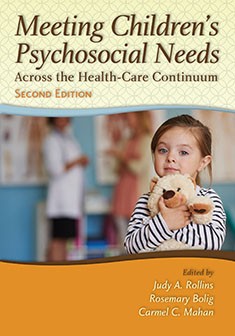Price $88.00
Meeting Children’s Psychosocial Needs Across the Health-Care Continuum, Second Edition captures the many developments in children’s health care since the last edition, integrating current research and theory within the framework of a new and transitioning health-care environment.
New to this second edition is the exploration of family and community issues and the impact on children’s psychosocial health and well-being. For, children in all settings continue to need nurturing, predictability, adequate stimulation, interaction, a sense of control, and mastery of their environments.
Chapter 1: Children’s Hospitalization and Other Health-Care Encounters discusses developmental approach to pediatric and family-centered care, and explores interventions that may make a difference in the reactions of children, siblings, and other family members to hospitalization and other encounters with the health-care system.
Chapter 2: Preparing Children for Health-Care Encounters explores stress, coping, and the history and theories behind various methods of preparing children for health-care encounters.
Chapter 3: Play in Children’s Health-Care Settings describes play, its functions and forms, the present theory and research on play, and the current thinking of play researchers in health care and other contexts.
Chapter 4: The Arts in Children’s Health-Care Settings discusses ways children use the arts for coping with illness and health-care experiences, describes related research findings and applications, and concludes with recommendations for individuals wishing to use the arts with children or to establish arts programming in children’s health-care settings.
Chapter 5: The Child with Special Health-Care Needs addresses psychosocial issues for children with special health-care needs in hospitals, the home, and the community.
Chapter 6: The Child Who Is Dying looks at the needs and issues of the child who is dying, the impact of death at home or in the hospital with palliative care, and the unique characteristics of grief for parents, siblings, grandparents, and others.
Chapter 7: Families in Children’s Health-Care Settings examines different types of families and explores issues health-care professionals need to consider when working with families along the health care continuum.
Chapter 8: The Health-Care Environment summarizes terms and objectives of psychosocial issues as defined by environmental psychologists, provides examples of alternative design philosophies, offers guidelines for pediatric hospitals and alternative caregiving environments, and describes controversial dimensions of healing environments.
Chapter 9: Spiritual Issues in Children’s Health-Care Settings provides an overview of spirituality, followed by theoretical and developmental aspects of spirituality and a description of spiritual care.
Chapter 10: Cultural Influences in Children’s Health Care presents the dimensions of culture, the within-group complexity found in culture, and information about developing cross-cultural competence.
Chapter 11: Ethical, Moral, and Legal Issues in Children’s Health Care reviews ethical, moral, and legal issues, challenges conventional thinking on these issues, and raises new issues to be faced.
Chapter 12: Relationships in Children’s Health-Care Settings explores relationships between health-care professionals and the children and families they serve, and relationships among members of the health-care team.
Chapter 13: Promoting Children’s Well-being in the Community discusses factors in the community that impact children’s well-being, community services for children, and the health-care professional as an agent of change.
Meeting Children’s Psychosocial Needs Across the Health-Care Continuum, Second Edition concludes with an Epilogue that addresses trends in children’s health care, providing thought-provoking ideas for new directions in psychosocial care of children and their families across the health-care continuum.
E-Book Instructor’s Manual is included with desk copy.
- Copyright 2018

 Proud to be Canadian
Proud to be Canadian